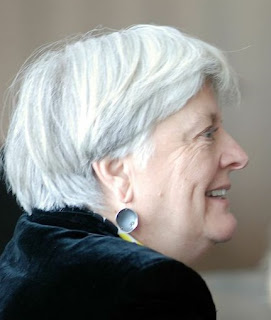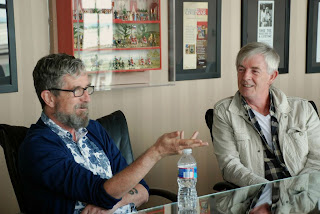| Les Waters, Madeleine Burnside & Bruce Simpson. |
By Kathi E. B. Ellis, special thanks to Todd Zeigler
Text copyright © 2013 by Kathi E. B. Ellis. All rights reserved.
Text copyright © 2013 by Kathi E. B. Ellis. All rights reserved.
Photos by Becky LeCron, Copyright © 2013 LeCron Photography.
Earlier this summer Arts-Louisville writer Kathi E.B. Ellis sat down for a conversation with the leaders of three major Louisville arts institutions: Madeleine Burnside, Executive Director of the Frazier History Museum; Bruce Simpson, Artistic Director of the Louisville Ballet; and Les Waters, Artistic Director of Actors Theatre of Louisville.
Each of these arts leaders has lived many places before he or she landed in Louisville – Bruce twelve years ago, Madeleine six years ago, and Les one year ago – bringing with them diverse and eclectic experiences within their individual art forms.
Of approximately the same generation, each of them left their native British Isles for similar reasons – they could not begin, or continue, their work there because of geography, because of opportunity, because of their relationship to British society in the late ’60s and early ’70s. Bruce acknowledges a resentment of having lived in so many countries, of cultures that he’s had to absorb; and yet he now realizes it’s “an actual fact in this kind of situation: it’s our biggest asset. Because, like a tourist, you have to look at 30,000 feet…you are looking from 30,000 at the community, where we are geographically, historically, socially. And at the same time we have to pay attention to the detail of Louisville.” And coming from a different culture, these artists bring a different set of expectations to the community. Les shared an anecdote when he was “complaining bitterly about something that really and truly, someone was being incredibly, not physically lazy, but incredibly mentally lazy. And I was saying ‘You really have to change and upgrade this to a different way of thinking.’ And they said, ‘Oh, but it’s okay for Louisville.’” There was immediate and comprehensive rejection of that point of view from everyone at the table, and a consensus that while there is a conservative element here towards what is “art,” there is also that “Keep Louisville Weird” vibe which brings a freedom and expansiveness to living and working in a city that doesn’t have everything figured out. Madeleine reflected that it’s actually a more healthy attitude than knowing everything. “I mean, when I grew up in London, it thought I knew what it was. You go back today and it’s totally, totally different. So evidently, despite knowing what you are, change is going to occur. So just get into it and realize it’s an ongoing process.”
None of them came straight to Louisville, but all agreed that “it was the job” that brought them here. Madeleine had interviews at two museums. “I didn’t have any plans to move here. I was interviewing for the job thinking that I was actually going to take a different job, but this would be worth looking at because someone I respected a lot had told me to take a look. And then when I walked in the door, I fell in love with the museum.” Les concurred, “It was the job. I mean…my career has mainly been in the producing and directing of new work. So when I lived in England and was working at The Royal Court, I knew about the Humana Festival [of New American Plays], and [Michael] Billington from The Guardian would go and review it and the theatre that I worked in had a long tradition of working with American writers… So I had a knowledge of it.” Bruce “totally agree[s] with that … it was the job… I had heard about the Louisville Ballet when I was working in Japan and South Africa. But mostly because of the influence of the British Commonwealth. I didn’t have much American influence in my career…and to know that the tradition Alan [Jones] and Helen [Starr] established here over a 25-year period was not just a great classical base but the opportunity [to] do really avant-garde work, I can take artistic risk within a very tight and disciplined classical framework.” Earlier in his career Bruce had met Thompson Smillie, who would later lead the Kentucky Opera, while Bruce was working as an extra for the Scottish Opera, little imagining that both would eventually lead two of Louisville’s major arts institutions.
 |
| Madeleine Burnside. |
Something each brings to “the job” is a capacity to re-vision an existing institution. For Madeleine, working at an institution whose core collection is one that explores more than a thousand years of history through the lens of the Royal Armoury’s holdings (the only U.S. site for these artifacts), the challenge is how to make what is, to Americans, arcane history accessible. When she came to the museum, she says that it felt like a school text book on the wall, and a British text book, not an American one. “I knew, as an Englishperson, I could persuade the Armory in a way that an American couldn’t.” As an Englishperson, her learning curve was American history; but the American learning curve is that they don’t know English history. Madeleine was in a unique position to bridge this gap and bring an insider/outsider perspective to re-creating how the Frazier would tell its story. Of course, she also faced a degree of institutional inertia, and during her first year, “someone actually said ‘we’ve always done it that way’ to me. And I said, ‘Oh for God’s sake, it’s three years old. There is no always.'” Part of that mantra is the undeniable fact that today’s audiences don’t return to museums just to see the permanent collection. As she says, there’s a reason that the Met programs visiting exhibitions – as does the Frazier, for example this past year’s “Spirits of the Passage” temporary exhibit spearheaded by the Frazier together with national and local partners.
Bruce’s programming lives in a world that can directly trace its antecedents to King Louis XIV in an almost direct and personal connection, choreographer to dancer, dancer to dancer; and yet for a ballet company to stay relevant today, “we have to have a company that reflects the dancers and the company have to reflect the community that we’re living in and the repertoire has to reflect the community we’re living in.” And for Bruce that includes having to “access a world that is not my birthright,” working at companies around the world with a corps of international dancers. In the twelve years he has been at the Louisville Ballet, Bruce has programmed the “war horse” ballets like Swan Lake and Giselle, as well as works by newer choreographers such as Val Caniparoli and Marc Hoagland, both featured in the upcoming season. He has also nurtured homegrown choreographic talents from within the company – ensuring that his art form’s direct line will continue and flourish out of Louisville.
 |
| Les Waters & Bruce Simpson. |
Les brings to Actors Theatre of Louisville a career of producing and directing new works both in England and in the U.S. Early on in this country he worked for Joe Papp at the Public Theatre. Back in England, he began his career at the Royal Court Theatre, which declared itself a writers’ theatre in its first year of operation. Thus Les had a familiarity with American writers and with ATL: “…The theatre had a high reputation, you know, I mean it seemed like a fit. I mean there are other regional theaters that I don’t think I’d be such a fit in.” As a working director, he says, he was at the stage of wondering, “What if the next boat is the boat that’s gonna shake me up?…What is it that would be the spark that moves me forward?” From Girlfriend to The Mountaintop and to future Humana offerings, Louisville is in the process of embarking on that journey with Les.
Being of a similar generation, these three artists, from very different backgrounds, nevertheless articulated passionate reasons for leaving England that express a common theme. “I left England when Maggie Thatcher became Minister of Education,” says Madeleine. “And you just knew it was going downhill because the first thing she said was ‘I’m going to cut the grants.”…It was the ’60s. I had huge, huge resentment for the system and went to California and got to actual march against the Vietnam War…. I just thought I had more of a voice here. It was a more interesting place. England wasn’t very interesting.” Les agrees. “I feel like this big here (holds out his arms) and I think in England, whenever I return…and I’m frightened of it in a sense, I feel like this big (measuring a space with his fingers), whether that’s true or an imaginary thing.” Bruce states that he had to leave Scotland if he wanted to become a dancer, “But I was certainly resentful for most of my life actually, because I was forced to leave Scotland at 18 because there was no Scottish ballet company. So I resented being the eternal tourist.” He continues, “In my mid-30s, I had a conversation with my mother about [returning to Scotland to work]…. I was seriously puzzled about why I couldn’t say “Yes.” She said, ‘You’re so full of resentment about what Scotland did to you when you were a teenager.’ And she was absolutely right. Yet, I came to American in 2002 for the specific reason that I could have gone back to Britain and been really comfortable at the age of 50 in my culture. You know. I could have driven on the left hand side of the road, I wouldn’t have to worry about a dialect or a ‘Glaswegian’ accent or anything like that. But the thing is, that would have been so boring and comfortable. I really wanted to use my life skills to get my butt kicked culturally, and certainly America can do that.”
Having three British ex-pats at the helm of a cultural institution in Louisville is not new. Bruce’s immediate predecessors at the Louisville Ballet were Welshman Alun Jones and Englishwoman Helen Starr; Thompson Smillie, a Scot, led the Kentucky Opera for many years; and Trish Pugh-Jones was a former Associate Director of Actors Theatre of Louisville with Jon Jory. Ms. Pugh-Jones has returned to her native Wales, but these other eternal tourists remain in the Louisville community. It’s the job that brought everyone of them here, and it’s something quintessentially American that keeps these three here. Finishing each other sentences, they all agree: “[It’s] like [America’s] being made up. It’s got really great traditions and inside of that it’s being made up…. It’s that whole thing of the optimism and about getting things done. We don’t know how to do it, but let’s just do it. It’s very attractive, for an artist.” And in summing up, almost in unison, “It’s the best.”
However long Madeleine, Bruce and Les make their life and work in Louisville, the community will benefit, as it has in previous generations, from these artists as eternal tourists who bring their cumulative cultural and artistic experiences into Louisville, demonstrating in each of their institutions one other belief on which they all agreed, as Bruce puts it, “…To the end of this day, especially in the arts, the absolute one thing that is completely essential is courage.”
Louisville Ballet presents Swan Lake
September 13 & 14 @ 8 p.m.
September 14 @ 2 p.m.
September 14 @ 2 p.m.
Noises Off runs through September 22 at Actors Theatre
Mythic Creatures runs through September 13 at Frazier History Museum




